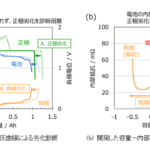将来的には、再生可能エネルギーによるエネルギーを貯蔵し、輸送に利用できるようになるかもしれない。 In the futuere the metal could store energy from renewable sources, for example for transportation
2022-12-02 マックス・プランク研究所
科学者たちは、金属、特に鉄がどのようにエネルギー貯蔵に利用できるのか、またどのパラメータが貯蔵・再利用の効率を決定するのかを分析しました。
鉄鉱石が鉄に還元されるとき、還元された鉄には当然ながら多くのエネルギーが蓄積されている。この鉄を酸化して酸化鉄に戻すことで、必要な時にいつでもこのエネルギーを取り出せるようにしようというものだ。風や太陽、水などのエネルギーが過剰な時には、この鉄鉱石を再び鉄に還元し、エネルギーを蓄えることができるのだ。科学者たちは、鉄を燃やして酸化させ、鉄鉱石に戻すことを「燃焼」と呼んでいる。
還元燃焼後の鉄粉の特性評価に着目し、最先端の顕微鏡法とシミュレーション法を用いて、粉の純度、形態、多孔性、燃焼プロセスの熱力学を分析した。燃焼した鉄粉の微細構造は、次の還元プロセスの効率と、還元と燃焼のプロセスが完全に循環しているかどうか、つまり追加のエネルギーや材料が必要ないかどうかを判断するのに決定的な役割を果たす。
研究者らは、プロパンパイロットフレームに支えられた燃焼経路と、鉄粉のみを燃料とする自立型の燃焼経路の2つを提示し、燃焼経路が燃焼した鉄の微細構造にどのような影響を与えるかを示しました。
今回の研究により、金属を使ったエネルギー貯蔵が実現可能であることが示されました。
<関連情報>
- https://www.mpg.de/19572788/iron-energy-storage?c=2249
- https://www.sciencedirect.com/science/article/abs/pii/S1359645422006413
鉄粉の燃焼に伴う相変態と組織形成の解明 Phase transformations and microstructure evolution during combustion of iron powder
Laurine Choisez,Niek E.van Rooij,Conrad J.M.Hessels,Alisson K.da Silva,Isnaldi R. Souza Filho,YanMa,Philipde Goey,HaukeS pringer,Dierk Raabe
Acta Materialia Available online :10 August 2022
DOI:https://doi.org/10.1016/j.actamat.2022.118261

Abstract
To successfully transition from fossil-fuel to sustainable carbon-free energy carriers, a safe, stable and high-density energy storage technology is required. The combustion of iron powders seems very promising in this regard. Yet, little is known about their in-process morphological and microstructural evolution, which are critical features for the circularity of the concept, especially the subsequent reduction of the combusted oxide powders back to iron. Here, we investigated two iron powder combustion pathways, one in air and one with the assistance of a propane pilot flame. Both processes resulted in spherical hollow particles composed of a complex microstructure of wüstite, magnetite and/or hematite. Partial evaporation is indicated by the observation of nanoparticles on the micro-sized combustion products. The associated gas production inside the liquid droplet could be the origin of the internal porosity and micro-explosion events. Cracking at the end of the combustion process results in mostly open porosity, which is favorable for the subsequent reduction process. With this study, we aim to open the perspective of iron metal fuel from macroscopic combustion analysis towards a better understanding of the underlying microscopic thermodynamic, kinetic, microstructural and thermomechanical mechanisms.



